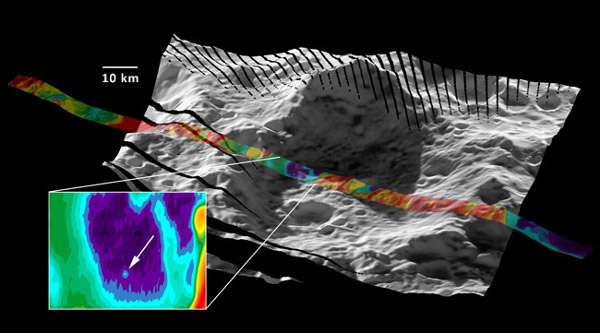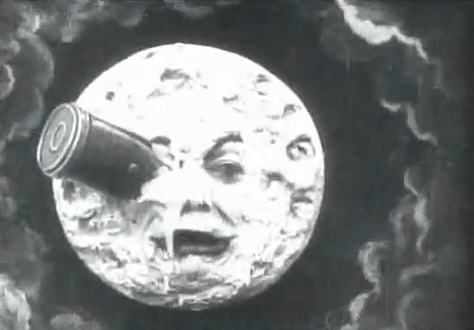| Tikalon Blog is now in archive mode.
An easily printed and saved version of this article, and a link
to a directory of all articles, can be found below: |
|
This article |
| Directory of all articles |
New Moon
October 25, 2010
Water, water, every where,
And all the boards did shrink;
Water, water, every where,
Nor any drop to drink.[1]
Aside from minor cinematic excursions,[2,3] the
Moon has always been considered to be dry and lifeless. Well, the lifeless part still holds, but the dry description doesn't, at least in selected areas. About a year ago,
NASA orchestrated a controlled 5,500 mile/hour impact of a space probe, called the
Lunar Crater Observation and Sensing Satellite (LCROSS), and its associated
Centaur rocket into a
crater on the Moon. This crater, named
Cabeus, is located in a southernmost region of the Moon that never gets direct sunlight, and the walls of the crater ensure that at least some portions of this lunar terrain haven't been warmed by the
Sun for billions of years. The temperature in these regions is about 40
K. The impact of the Centaur rocket ejected a plume of lunar material nearly ten miles high, and instruments on LCROSS and the
Lunar Reconnaissance Orbiter (LRO) detected
water ice in the plume. The likely source of this water is
comets that have impacted the Moon over its history, although some scientists think this water may have been part of the Moon originally. Most of the water vapor from these comets escaped into space, but some coalesced in cool regions, such as Cabeus.[4-7]
Water is not the end of the story, since a sextet of articles in the current issue of
Science show evidence for other
volatile materials that may be useful to future lunar explorers.[8-13] The impact revealed
methane,
ammonia,
hydrogen,
carbon dioxide and
carbon monoxide, as well as relatively large amounts of
sodium,
mercury, and possibly
silver. These volatiles could have formed through reaction of water with the lunar
regolith in a process termed, "cold grain chemistry." Since
chemical reaction rates are usually very slow at low temperatures, such reactions with water could have taken hundreds of thousands of years. A refinement of the water data indicates that Cabeus as a whole may contain a billion gallons of water. The plume itself contained about 41 gallons of water, and when the data is extrapolated to the crater as a whole, the density of water is about twice that of the Sahara desert.
How, exactly, do you remotely detect chemical elements this way? LCROSS had five cameras (one
visible, two
near infrared and two
mid-infrared), three
spectrometers (one visible and two near infrared) and a
photometer. The LRO has several other instruments, including the Lunar Exploration
Neutron Detector for measuring hydrogen, the
Lyman Alpha Mapping Project (LAMP) that detects elements via their
ultraviolet spectra, and the
Diviner Lunar Radiometer for measuring temperature. The Diviner registered a maximum impact temperature of 675 degrees
Celsius. Plugging in
heat capacities of lunar material and the other variables, this would have been sufficient to evaporate about 300 kilograms of water ice. Aside from molecular hydrogen and carbon monoxide, LAMP detected
calcium,
magnesium, and
mercury. It's conjectured that mercury has been boiled off from other parts of the Moon and transported to cooler regions like Cabeus. Mercury exists in about the same concentration as water, so lunar explorers will need to bring some water filters.

Temperatures at the Cabeus crash site about 90 seconds after impact, as measured by the Lunar Reconnaissance Orbiter. The impact generated temperatures of about 675 degrees C, which appear as a tiny glowing dot near the center of the color swath. (NASA/UCLA).
The scant twenty-three pages of articles in Science belie the technical effort required to carry out these experiments. The impact needed to be precise, and the Moon, of course, is a moving target. Spacecraft typically use
guide stars to fix their navigation through space. LCROSS needed to use the different approach of utilizing "guide craters." The plan originally called for an impact at a smaller crater called Cabeus A, but hydrogen concentration data from the LRO showed that Cabeus was a better candidate, and the course had to be corrected at a late stage.
The Cabeus impact reminds me of a
science fiction short story I read many years ago (title and author unknown).
Earth did an experiment to detect the composition of
Mars by sending an
atomic bomb to explode on its surface. Unfortunately, the bomb destroyed the only city on Mars and the
last of the Martians. Hopefully, no
Selenites were harmed during the collection of these data.

Still from Méliès' Le Voyage dans la lune. [2]
![]()
References:
- The Rhyme of the Ancient Mariner by Samuel Taylor Coleridge.
- Le voyage dans la lune (A Trip to the Moon, Georges Méliès, Director), 1902. YouTube video is available here.
- Cat-Women of the Moon (Arthur Hilton, Director), 1953.
- Michael Braukus, "LCROSS Results Released," NASA Press Release 10-271, October 21, 2010.
- Amina Khan, "Moon is wetter, chemically more complex than thought, NASA says," Los Angeles Times, October 22, 2010.
- Suzanne Presto, "NASA Searches for Water on Moon," Voice of America News, October 21, 2010.
- Charles Q. Choi, "How NASA's Bold Moon Crash Almost Bombed," Space.com, October 21, 2010.
- Anthony Colaprete, Peter Schultz, Jennifer Heldmann, Diane Wooden, Mark Shirley, Kimberly Ennico, Brendan Hermalyn, William Marshall, Antonio Ricco, Richard C. Elphic, David Goldstein, Dustin Summy, Gwendolyn D. Bart, Erik Asphaug, Don Korycansky, David Landis and Luke Sollitt, "Detection of Water in the LCROSS Ejecta Plume," Science, vol. 330, no. 6003 (October 22, 2010), pp. 463-468
- Peter H. Schultz, Brendan Hermalyn, Anthony Colaprete, Kimberly Ennico, Mark Shirley and William S. Marshall, "The LCROSS Cratering Experiment," Science, vol. 330, no. 6003 (October 22, 2010), pp. 468-472.
- G. Randall Gladstone, Dana M. Hurley, Kurt D. Retherford, Paul D. Feldman, Wayne R. Pryor, Jean-Yves Chaufray, Maarten Versteeg, Thomas K. Greathouse Andrew J. Steffl, Henry Throop, Joel Wm. Parker, David E. Kaufmann, Anthony F. Egan, Michael W. Davis, David C. Slater, Joey Mukherjee, Paul F. Miles, Amanda R. Hendrix, Anthony Colaprete and S. Alan Stern, "LRO-LAMP Observations of the LCROSS Impact Plume,"Science, vol. 330, no. 6003 (October 22, 2010), pp. 472-476.
- Paul O. Hayne, Benjamin T. Greenhagen, Marc C. Foote, Matthew A. Siegler, Ashwin R. Vasavada and David A. Paige, "Diviner Lunar Radiometer Observations of the LCROSS Impact," Science, vol. 330, no. 6003 (October 22, 2010), pp. 477-479
- David A. Paige, Matthew A. Siegler, Jo Ann Zhang, Paul O. Hayne, Emily J. Foote, Kristen A. Bennett, Ashwin R. Vasavada, Benjamin T. Greenhagen, John T. Schofield, Daniel J. McCleese, Marc C. Foote, Eric DeJong, Bruce G. Bills, Wayne Hartford, Bruce C. Murray, Carlton C. Allen, Kelly Snook, Laurence A. Soderblom, Simon Calcutt, Fredric W. Taylor, Neil E. Bowles, Joshua L. Bandfield, Richard Elphic, Rebecca Ghent, Timothy D. Glotch, Michael B. Wyatt and Paul G. Lucey, "Diviner Lunar Radiometer Observations of Cold Traps in the Moon’s South Polar Region," Science, vol. 330, no. 6003 (October 22, 2010), pp. 479-482.
- I. G. Mitrofanov, A. B. Sanin, W. V. Boynton, G. Chin, J. B. Garvin, D. Golovin, L. G. Evans, K. Harshman, A. S. Kozyrev, M. L. Litvak, A. Malakhov, E. Mazarico, T. McClanahan, G. Milikh, M. Mokrousov, G. Nandikotkur, G. A. Neumann, I. Nuzhdin, R. Sagdeev, V. Shevchenko, V. Shvetsov, D. E. Smith, R. Starr, V. I. Tretyakov J. Trombka, D. Usikov, A. Varenikov, A. Vostrukhin and M. T. Zuber, "Hydrogen Mapping of the Lunar South Pole Using the LRO Neutron Detector Experiment LEND," Science, vol. 330, no. 6003 (October 22, 2010), pp. 483-486.
Permanent Link to this article
Linked Keywords: Moon; NASA; Lunar Crater Observation and Sensing Satellite (LCROSS); Centaur; crater; Cabeus; Sun; Kelvin temperature scale; Lunar Reconnaissance Orbiter (LRO); water ice; comets; Science; volatile; methane; ammonia; hydrogen; carbon dioxide; carbon monoxide; sodium; mercury; silver; chemical reaction rates; visible; near infrared; mid-infrared; spectrometer; photometer; neutron; Lyman Alpha; ultraviolet; Diviner Lunar Radiometer; Celsius; heat capacity; calcium; magnesium; mercury; guide star; Canopus; science fiction; Earth; Mars; atomic bomb; Marvin the Martian; Selenites; The Rhyme of the Ancient Mariner; Samuel Taylor Coleridge; Le voyage dans la lune; Cat-Women of the Moon.